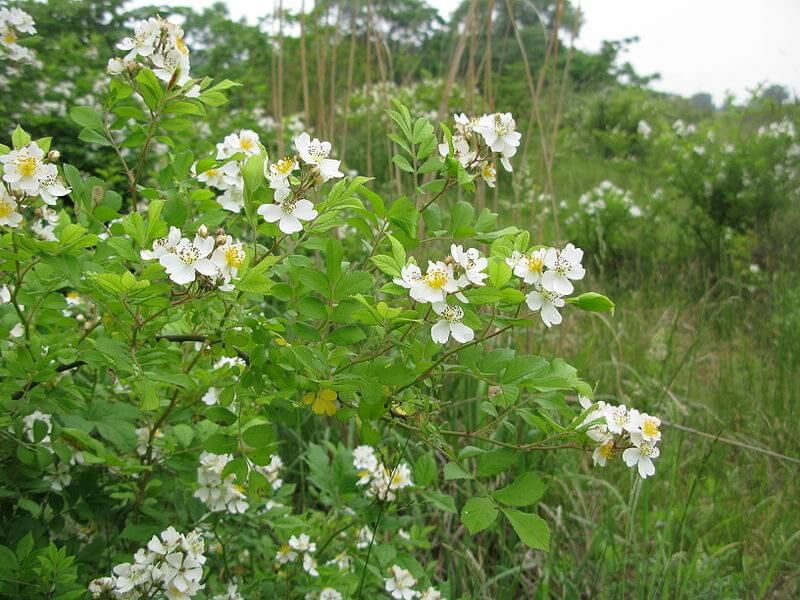More on Invasive Plants
by Dale Finseth

An invasive plant is not native to a particular area; can cause harm to the environment, the economy, or human health; and can establish and spread in natural areas. While only a small fraction of our non native plants are considered invasive, once you learn recognize a few of them, you'll find that they seem to be everywhere.
This week I'll discuss a few of those that seem more prevalent or on the increase. Those we readily identify are Japanese knotweed, which some people refer to it as bamboo; multiflora rose, which are those large clumps of white flowers often seen in abandoned fields (see photo); honeysuckle, which often takes over at the wood's edge; and autumn olive, which is a very fragrant shrub often found on roadsides. Others we have recently seen spread are Japanese barberry, a thorn covered shrub with groups of leaves along the twig, and Asiatic bittersweet vine with its tree-choking habit. Most of these plants are already established in parts of Kennebec County. Management can best be done by knowing what they look like and limiting their spread. That is an ongoing effort, since we are unlikely to completely eradicate them.
However, there are other invasives that we still have a chance to control and limit their spread. The tree of heaven, giant hogweed (which also a dangerous health hazard), and the pale swallowwort vine are examples of these. These plants are not widely established in this part of the State yet. If you identify them and carefully remove them you can help to limit their spread. The goal for these is total eradication from the site.
Check the Maine Natural Areas Program list of fact sheets to determine if a particular species is considered invasive in Maine and which may be an "early detection" variety. The Maine Natural Area Program is the "go to" state agency in Maine for answering questions and getting information about invasive plants.
There is also a generic State website for all types of invasives, i.e. animals, forest pests, aquatic plants, and terrestrial plants. These websites have "gallery views" available, which provide good photos to use in identification.
There is also a new, publication, the Maine Invasive Plant Field Guide. It is a handy 3.75″ x 8″ field guide mounted on rings, so that it is easy to flip through. Click the link above for ordering information. The cost is $30, including tax and mailing.
Finally, you get handouts on invasives through the Maine Lakes Resource Center in Belgrade Lakes Village, the University of Maine Cooperative Extension, or our office.
Locally we need to come to grips with the invasive plants that are damaging our natural areas, habitat and native plants. These invasive plants can become established by our own actions if we plant them by mistake, i.e. burning bush and autumn olive were often planted by homeowners. Or we could mistakenly allow an invasive to become established in our back yard. Check the edge of the woods on your property and any overgrown areas. That is often the area where the invasive plants can become established.
- When buying plants for your yard, select native plants.
- Replace invasive plants in your garden with non-invasive alternatives.
- Monitor your property in order to identify and eradicate invasives before they become established.
- DO NOT attack the problem with in discriminant herbicide use. They may have a place in your management plan but they are NOT a magic bullet. Be careful with their use.
- Check out the Maine Natural Areas IMapInvasive program and become a citizen scientist.
Our natural landscape is part of what Maine is all about. Maine just won't be Maine if the plants dominating our landscape are all from away.
Now retired, Dale Finseth was executive director of the Kennebec County Soil & Water Conservation District from 2001 to 2024.
<— Previous Article • Summaries • Next Article —>
©2021 by Summertime in the Belgrades. All rights reserved.

